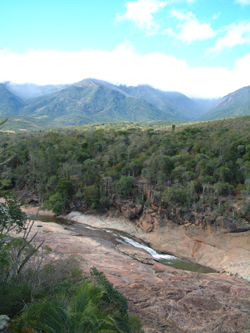Andohahela National Park
| Andohahela National Park | |
|---|---|
| Location | Anosy - southern Madagascar |
| Nearest city | Tôlanaro (Fort Dauphin) |
| Coordinates | 24°36′3″S 46°41′58″E / 24.60083°S 46.69944°E |
| Area | 760 km2 |
| Established | 1998[1] |
| Visitors | approx. 1300 (in 2005) |
| Governing body | Madagascar National Parks Association |
Andohahela National Park, in south-east Madagascar, is remarkable for the extremes of habitats that are represented within it. The park covers 760 km2 (293 sq mi) of the Anosy mountain range, the southernmost spur of the Malagasy Highlands and contains the last humid rainforests in the southern part of Madagascar.
The Park was inscribed in the World Heritage Site in 2007 as part of the Rainforests of the Atsinanana.[2]
History
Andohahela has been a protected area since 1939 but did not become a national park until 1998.[1]
Geography
Andohahela National Park is 40 kilometres (25 mi) north-west of Tôlanaro and at the southern end of the Malagasy Highlands. The park is divided into three zones. The first, Malio ranges from 100 metres (330 ft) to the summit of Pic d' Andohahela at 1,956 metres (6,417 ft), and has dense rainforest with more than two hundred species of tree ferns, orchids, wild vanilla, lemurs and many birds. The second, Ihazofotsy-Mangatsiaka, contains dry spiny forest with rare birds and reptiles in altitudes ranging from 100 metres (330 ft) to 1,005 metres (3,297 ft) at the summit of Pic de Vohidagoro. The third zone, Tsimelahy, is mainly at an altitude of 125 metres (410 ft), contains the unique Ranopiso transitional forest. The mountains form a natural barrier to the moist trade winds that blow from the east, causing a rainfall of 1,500–2,000 millimetres (59–79 in) per year on the eastern side that supports one of the few rainforests south of the Tropic of Capricorn. At the western edge of the park, the rainfall is just 600–700 millimetres (24–28 in) per year and the resulting vegetation is a dry spiny forest characteristic of southern Madagascar.[1][3]
Several circuits within each of the habitat types of the park can be accessed by road from the town of Tolagnaro. Detailed information on arranging trips is available from the tourism information office or from the Madagascar National Parks Association office in Tolagnaro.[1]
Flora and fauna

The variety of habitats within Andohahela is mirrored in the richness of species that are found there, and the park is the richest place in Madagascar for lemurs. Fifteen species have been recorded, including two of Madagascar's most emblematic species, the ring-tailed lemur and Verreaux's sifaka.[3] Some rare species of geckos, turtles and snakes are among the 67 species of reptiles found in the park, 130 species of birds and fifty species of amphibians. The Triangle palm is only found here.[1]
| Location | Habitat Type | Species |
|---|---|---|
| Malio (Parcel 1) | Rain forest |
Day viewing:
Night viewing:
|
| Ihazofotsy (Parcel 2) | Spiny forest |
Day viewing:
Night viewing:
|
| Tsimelahy (Parcel 3) | Transitional forest |
|
See also
References
- ^ a b c d e "Andohahela National Park". Travel Madagascar. Retrieved 29 October 2016.
- ^ "Nomination of natural, mixed and cultural properties to the world heritage list - Rainforests of the Atsinanana". UNESCO World Heritage. Retrieved 29 October 2016.
- ^ a b Preston-Mafham, Ken (1991). Madagascar: A Natural History. Oxford: Facts On File. p. 211. ISBN 0 8160 2403 0.
- ^ Mittermeier, R.A.; Louis, E.E.; Richardson, M.; Schwitzer, C.; et al. (2010). Lemurs of Madagascar. Illustrated by S.D. Nash (3rd ed.). Conservation International. p. 633. ISBN 978-1-934151-23-5. OCLC 670545286.


